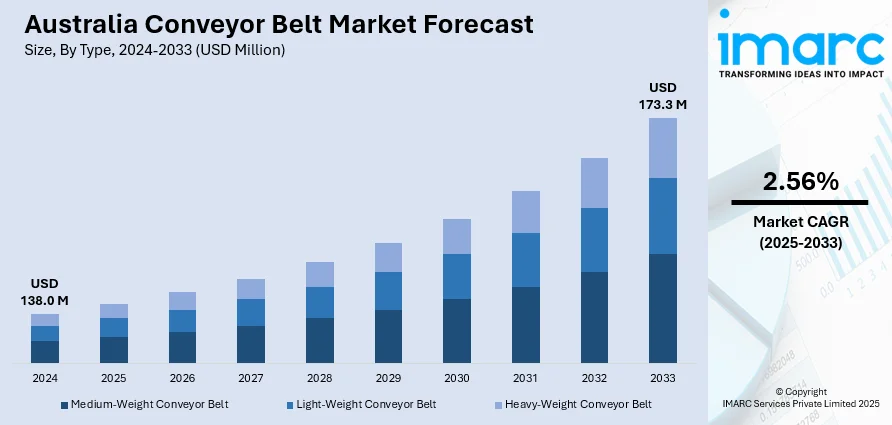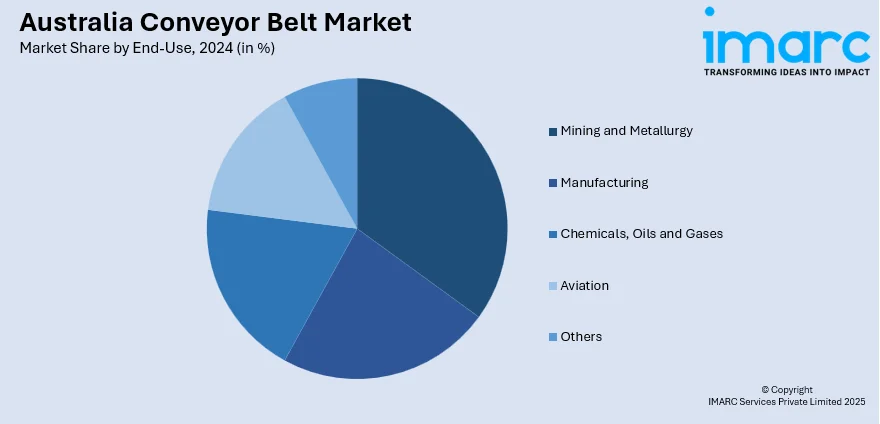
Australia Conveyor Belt Market Size, Share, Trends and Forecast by Type, End-Use, and Region, 2025-2033
Australia Conveyor Belt Market Overview:
The Australia conveyor belt market size reached USD 138.0 Million in 2024. Looking forward, IMARC Group expects the market to reach USD 173.3 Million by 2033, exhibiting a growth rate (CAGR) of 2.56% during 2025-2033. Smart technology adoption and sustainability movements fuel the Australian conveyor belt market. IoT, AI, and predictive maintenance improve efficiency in operations. Eco-friendly materials and energy-efficient systems are also transforming industry standards, thereby promoting green initiatives and cutting costs.
|
Report Attribute
|
Key Statistics
|
|---|---|
|
Base Year
|
2024
|
|
Forecast Years
|
2025-2033
|
|
Historical Years
|
2019-2024
|
| Market Size in 2024 | USD 138.0 Million |
| Market Forecast in 2033 | USD 173.3 Million |
| Market Growth Rate 2025-2033 | 2.56% |
Australia Conveyor Belt Market Trends:
Smart Technologies Transforming Conveyor Systems
The Australian conveyor belt industry is experiencing a revolution with the introduction of smart technology fueled by efficiency and predictive maintenance requirements. Moreover, intelligent conveyor systems with sensors and IoT connectivity are being adopted in industries. They facilitate real-time monitoring of essential parameters such as belt speed, load, and temperature, creating useful data for analysis. In line with this, the emergence of AI and machine learning algorithms assists in processing the data, providing predictive maintenance insights. This minimizes unplanned downtimes, increases system life, and maximizes performance. Smart conveyor systems can also be monitored and controlled remotely, enhancing operational flexibility. Organizations such as Fenner Dunlop have advanced solutions that include predictive analytics for proactive management. The trend represents a wider industry shift towards automation and data-driven decision-making. Firms are increasingly investing in technologies that not only enhance productivity but also lower maintenance costs and operational risks. The increasing demand for digitalization in sectors such as mining, logistics, and manufacturing further fuels this trend.

To get more information on this market, Request Sample
Sustainability and Energy Efficiency Driving Growth
Sustainability and energy efficiency are the major drivers in the Australian conveyor belt industry. Increased environmental awareness and regulation have spurred industries towards adopting green solutions. The focus is shifting towards conveyor belts constructed from recyclable materials, minimizing environmental degradation while providing durability. Energy-efficient conveyor belts are becoming increasingly popular with new technologies such as low-friction belts and optimally designed drive motors reducing energy use significantly. These technologies assist in lowering operational expenses and are in line with corporate sustainability initiatives. Business sectors are also embracing energy recovery systems to ensure maximum effectiveness and lower waste. The focus on sustainability is not only regulatory but also consumer-driven, with consumers demanding sustainable business practices. Businesses are investing in research and development to formulate products that are eco-friendly and compliant without losses in performance. This trend is likely to continue as Australia's industries put green technologies at the top of their agendas.
Australia Conveyor Belt Market Segmentation:
IMARC Group provides an analysis of the key trends in each segment of the market, along with forecasts at the country level for 2025-2033. Our report has categorized the market based on type and end-use.
Type Insights:
- Medium-Weight Conveyor Belt
- Light-Weight Conveyor Belt
- Heavy-Weight Conveyor Belt
The report has provided a detailed breakup and analysis of the market based on the type. This includes medium-weight conveyor belt, light-weight conveyor belt, and heavy-weight conveyor belt.
End-Use Insights:

- Mining and Metallurgy
- Manufacturing
- Chemicals, Oils and Gases
- Aviation
- Others
A detailed breakup and analysis of the market based on the end-use have also been provided in the report. This includes mining and metallurgy, manufacturing, chemicals, oils and gases, aviation, others.
Regional Insights:
- Australia Capital Territory & New South Wales
- Victoria & Tasmania
- Queensland
- Northern Territory & Southern Australia
- Western Australia
The report has also provided a comprehensive analysis of all the major regional markets, which include Australia Capital Territory & New South Wales, Victoria & Tasmania, Queensland, Northern Territory & Southern Australia, and Western Australia.
Competitive Landscape:
The market research report has also provided a comprehensive analysis of the competitive landscape. Competitive analysis such as market structure, key player positioning, top winning strategies, competitive dashboard, and company evaluation quadrant has been covered in the report. Also, detailed profiles of all major companies have been provided.
Australia Conveyor Belt Market News:
- August 2024: BOTON launched its Global Technical Service Centre and Australian Innovation Laboratory in Perth, marking a significant development in the conveyor belt segment. This expansion, supported by key mining partners, boosted local R&D, enhanced service capabilities, and strengthened Australia’s position as a mining technology hub.
- August 2024: Martin Engineering expanded its operations in Australia with a new manufacturing facility in Yatala and a fully staffed office in Perth. This development enhanced local conveyor belt accessory production, improved service efficiency, created jobs, and strengthened Australia’s bulk handling industry.
Australia Conveyor Belt Market Report Coverage:
| Report Features | Details |
|---|---|
| Base Year of the Analysis | 2024 |
| Historical Period | 2019-2024 |
| Forecast Period | 2025-2033 |
| Units | Million USD |
| Scope of the Report |
Exploration of Historical Trends and Market Outlook, Industry Catalysts and Challenges, Segment-Wise Historical and Future Market Assessment:
|
| Types Covered | Medium-Weight Conveyor Belt, Light-Weight Conveyor Belt, Heavy-Weight Conveyor Belt |
| End-Uses Covered | Mining and Metallurgy, Manufacturing, Chemicals, Oils and Gases, Aviation, Others |
| Regions Covered | Australia Capital Territory & New South Wales, Victoria & Tasmania, Queensland, Northern Territory & Southern Australia, Western Australia |
| Customization Scope | 10% Free Customization |
| Post-Sale Analyst Support | 10-12 Weeks |
| Delivery Format | PDF and Excel through Email (We can also provide the editable version of the report in PPT/Word format on special request) |
Key Questions Answered in This Report:
- How has the Australia conveyor belt market performed so far and how will it perform in the coming years?
- What is the breakup of the Australia conveyor belt market on the basis of type?
- What is the breakup of the Australia conveyor belt market on the basis of end-use?
- What are the various stages in the value chain of the Australia conveyor belt market?
- What are the key driving factors and challenges in the Australia conveyor belt market?
- What is the structure of the Australia conveyor belt market and who are the key players?
- What is the degree of competition in the Australia conveyor belt market?
Key Benefits for Stakeholders:
- IMARC’s industry report offers a comprehensive quantitative analysis of various market segments, historical and current market trends, market forecasts, and dynamics of the Australia conveyor belt market from 2019-2033.
- The research report provides the latest information on the market drivers, challenges, and opportunities in the Australia conveyor belt market.
- Porter's five forces analysis assist stakeholders in assessing the impact of new entrants, competitive rivalry, supplier power, buyer power, and the threat of substitution. It helps stakeholders to analyze the level of competition within the Australia conveyor belt industry and its attractiveness.
- Competitive landscape allows stakeholders to understand their competitive environment and provides an insight into the current positions of key players in the market.
Need more help?
- Speak to our experienced analysts for insights on the current market scenarios.
- Include additional segments and countries to customize the report as per your requirement.
- Gain an unparalleled competitive advantage in your domain by understanding how to utilize the report and positively impacting your operations and revenue.
- For further assistance, please connect with our analysts.
 Request Customization
Request Customization
 Speak to an Analyst
Speak to an Analyst
 Request Brochure
Request Brochure
 Inquire Before Buying
Inquire Before Buying




.webp)




.webp)












